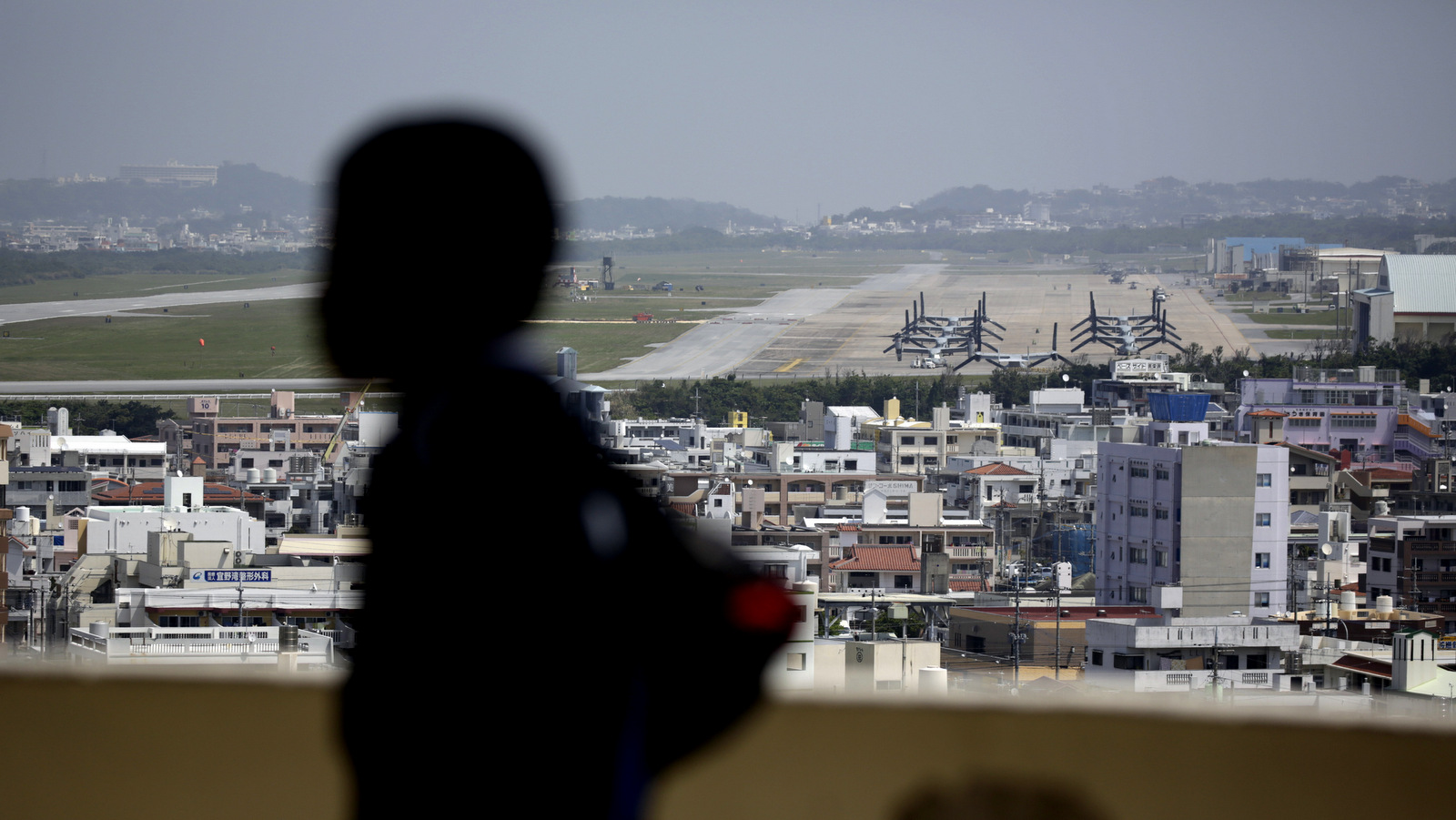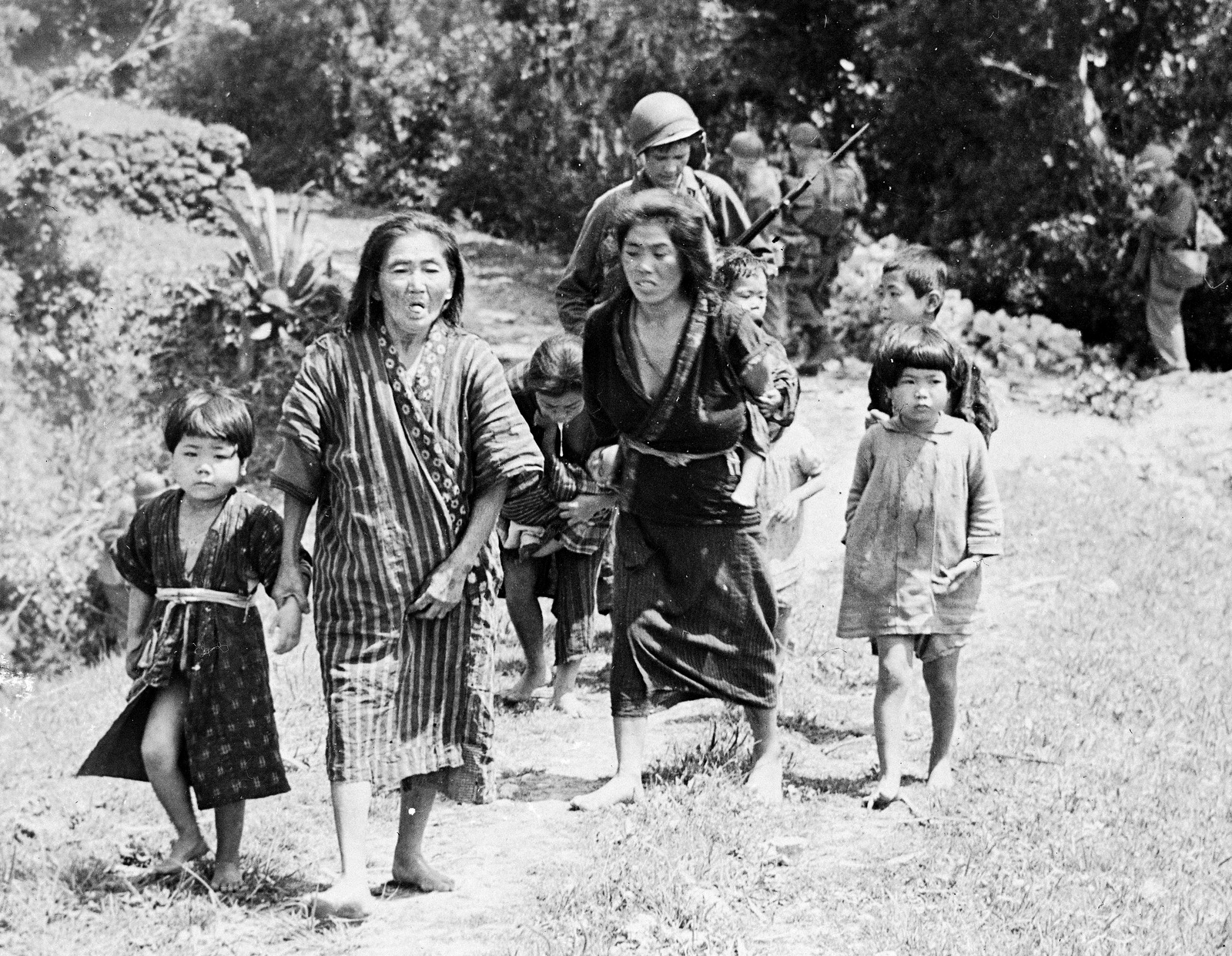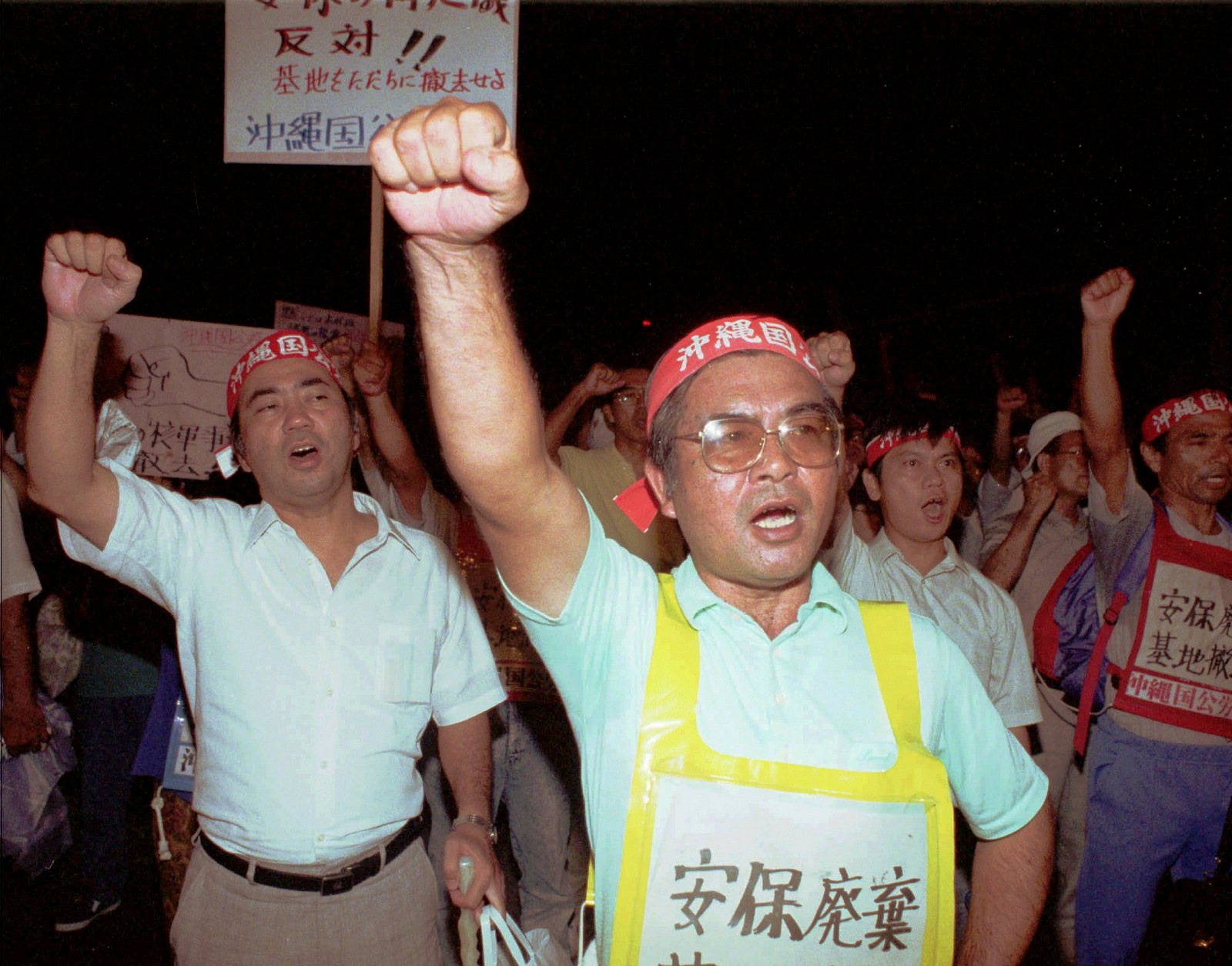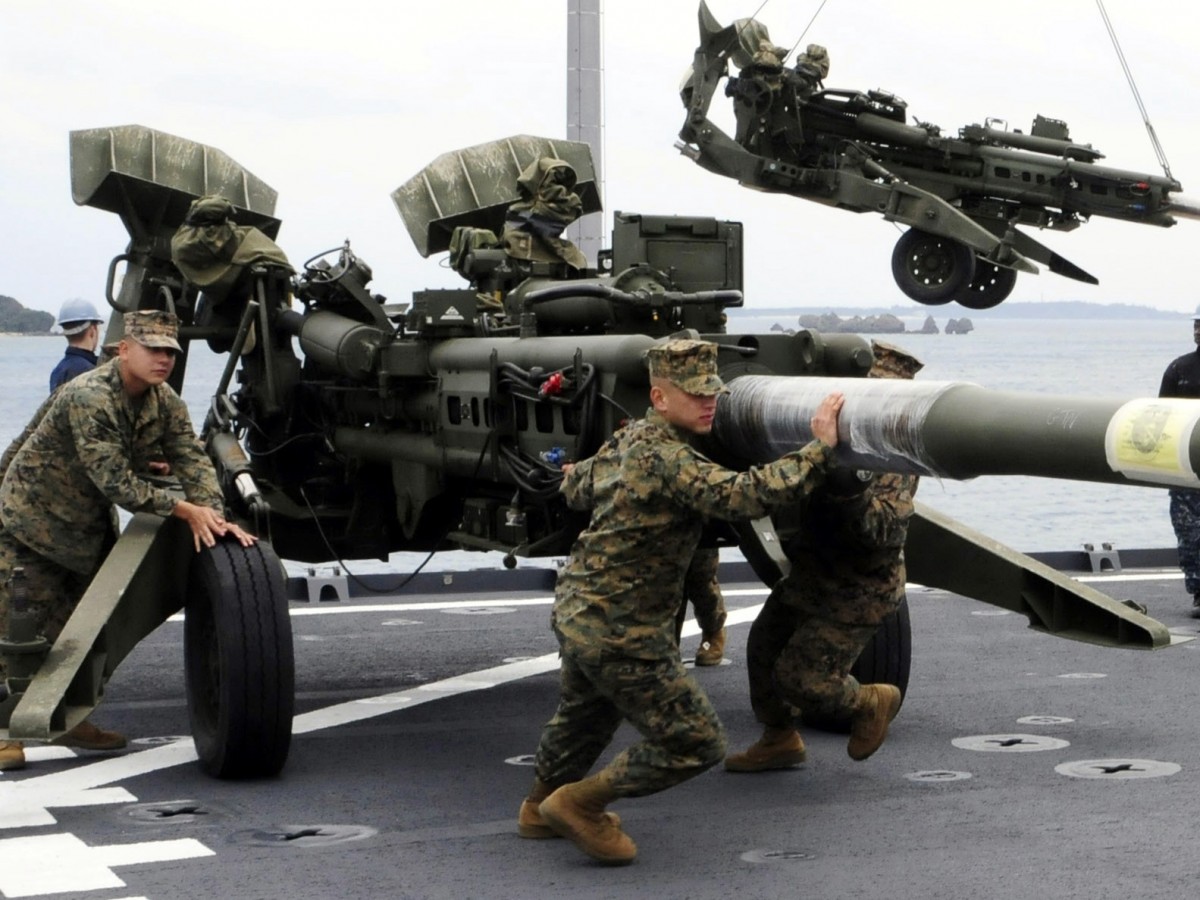GINOWAN CITY, OKINAWA — A spate of recent incidents surrounding U.S. Marine Corps Air Station Futenma has shaken the residents of the densely populated city of Ginowan, Okinawa, thrusting the tense history of relations between Japan, the U.S. military, and the locals in Okinawa Prefecture back into the global spotlight.
Nearly half of the 50,000 U.S. troops stationed in Japan are based in Okinawa’s islands, where locals have been forced to tolerate an American military footprint that has included prostitution, environmental degradation, sexual violence including pedophilia, and a range of other abuses and hazards.
As tensions on the Korean peninsula surrounding North Korea’s nuclear programs and weapons development have heated up, Okinawans have noticed a significant uptick in activity on U.S. bases — as well as mishaps involving U.S. aircraft.
Falling flotsam endangering children

A child looks at the U.S. Marine Corps Futenma Air Station and the surrounding area from an observation deck at a park in Ginowan, Okinawa Prefecture on southern Japan, March 23, 2015 (AP/Eugene Hoshiko)
On December 7, 2017, a small plastic canister loudly separated from a Marine Corps CH-53E Super Stallion flying low over Ginowan’s Midorigaoka nursery school, where a group of one-year-old children were about to play. The canister landed on the preschool’s roof. Amid anger from parents and staff, who began collecting signatures for a petition demanding the base’s removal, U.S. personnel claimed there was little possibility that the part fell from its chopper.
Less than a week later on Dec. 13, a metal window frame, measuring about 3-by-3 feet, fell from another CH-53E chopper onto a sports field at Futenma Daini Elementary School, where over 50 students were taking part in gym class. A young boy was slightly injured. Since then, the school has disallowed children from going out onto the grounds and have even discussed installing a shelter for children.
Read more by Elliott Gabriel
- “On the Offensive”: US State Dept. Gives $40M Boost to “Troll Farm” Propaganda Efforts
- Coke, Nestle Near Ownership of World’s Second Largest Aquifer
- Israel Ramps Up Support For Over 7 Syrian Rebel Factions In Desperate Bid to Expand Reach
- Operation Pacific Eagle: The US and Duterte Take Aim at China and the Armed Poor
U.S. military officials, long subject to the anxiety and anger of Okinawa’s weary residents, scrambled to apologize and assure locals that safety checks were completed and new instructions issued to the crew to try to avoid flights over the children’s schools.
Since then, multiple overflights have continued to take place above the school, outraging locals and deepening a perception that U.S. military forces stationed in Japan still behave as an occupation force. In early February, yet another military component – this time a part of an air intake from an MV-22 Osprey – washed ashore on Okinawa’s Ikei Island.
During a press conference at the Foreign Correspondents’ Club of Japan on February 14, the nursery school’s headmaster, Takehiro Kamiya, told reporters:
Every day U.S. military helicopters and Ospreys fly over our nursery school … There have been no apologies and no explanations of any kind to date.”
The Japanese Ministry of Defense reports that at least 25 similar incidents involving U.S. aircraft took place in the country last year, the majority of which were in Okinawa, according to Al Jazeera.
The incidents have stirred up a long-seething spirit of resistance to the U.S. troop presence on Okinawa, which has persistently been accompanied by sexual abuse, crime pollution, and “accidental” deaths and injuries inflicted on locals.
Okinawa’s “double colonization” by Japan and the U.S.

Japanese women and children are moved down a road in Okinawa shortly after American forces invaded Ryukyu island, April 6, 1945. (AP Photo)
The modern history of Okinawa has been one of constant victimization, dispossession and violence at the hands of foreign occupiers. The Okinawan or Ryukyuan people once ruled their own kingdom prior to the brutal conquest and annexation of the island chain by nearby Japan in the late 19th century. When the Okinawans lost their independence in 1879, the Japanese moved to deprive them of their language and their culture while subjecting them to economic exploitation and impoverishment as second-class subjects of the empire, akin to the people of Taiwan or Korea.
In 1945, the island was subject to the 82-day Battle of Okinawa, known by locals as the “typhoon of steel.” Anywhere from an estimated one-third to half of the pre-war population were abused, starved, murdered or subject to forced suicides by the Imperial Japanese Army, or died in the relentless U.S. military onslaught. As the American troops advanced, locals of all stripes — civilians, women, children and captured soldiers — were confined to U.S. military internment camps.
Following the battle, locals entertained a brief hope that their sovereignty would be regained and the abuse would end.
These expectations proved short-lived, as the U.S., operating with the consent of the postwar Japanese government, quickly applied Japan’s same methods of blatant colonialism to the war-ravaged island. Okinawa was placed under direct military rule; the internment camps remained; and vast swathes of private land were confiscated to make way for military bases to be used during the Cold War. Demands for labor, civil, political, economic and social rights were ignored as the island became a U.S. garrison devoted solely to the U.S. appetite for cheap Okinawan labor and limitless access to the skies, sea and land of Okinawa.
Even today, nearly 20 percent of the main island of Okinawa remains occupied by U.S. military bases. In Ginowan City, the Futenma air station is now surrounded by a dense landscape of residential neighborhoods, schools, hospitals, and infrastructure that support the troop presence.
For World War II survivors and locals who grew up in the shadow of the base, the explosive noises emanating from the base and its aircraft have triggered insomnia and post-traumatic stress disorder, according to residents.
Patience reaches its limits as Okinawans struggle to drive out U.S. bases

Workers clench their fists and shout slogans in front of the gate of Camp Foster, a U.S. Marine base, in Ginowan, northeast of Okinawa’s largest city of Naha Tuesday evening, Sept. 26, 1995. Some 3,000 islanders held a rally and took the streets to protest the rape of an Okinawan schoolgirl by three U.S. servicemen. (AP/Koji Sasahara)
In September, 1995, the anger of Okinawa’s long-suffering community reached a new peak after the gang-rape of a 12-year-old girl by three U.S. Marines, thrusting locals’ plight into the global spotlight. The incident ignited huge protests, as residents demanded that the tens of thousands of U.S. military personnel be withdrawn or that the U.S.-Japan Status of Forces Agreement (SOFA) be changed to ensure that U.S. troops suspected of crimes be handed over to local authorities.
The calls largely went unheeded. With each subsequent incident of abuse – including numerous incidents of rape, murder and fatal drunk-driving accidents – anti-U.S. sentiment swelled, only to be greeted with attempts by Tokyo and Washington to calm Okinawans down. In May, 2016, amid massive protests in Okinawa following the gruesome rape and murder of Rina Shimabukuro by U.S. military contractor Kenneth Gadson, then-President Barack Obama pledged the U.S.’s cooperation with the investigation into the murder and his willingness to “ensure justice is done under the Japanese legal system. ” Of course, the SOFA granting immunity to U.S. military personnel and civilian contractors remained largely non-negotiable.
Now, as Japan’s Prime Minister Shinzo Abe of the ruling right-wing Liberal Democratic Party (LDP) continues to beat the drums of war over the nuclear crisis on the Korean peninsula, in hopes to revise Japan’s security framework and remilitarize the country, the stage has been set for the continued exploitation of Okinawa as a staging-ground for military activities in the region.
Tokyo’s plans to redouble its usage of Okinawa as a military garrison appeared to be confirmed Tuesday as local media reports claimed that Japan is moving forward to deploy surface-to-ship missiles on the prefecture’s Miyako and Ishigai islands, in preparation for a potential conflict with China regarding the disputed Senkaku (or Diaoyu) islands.
Defense Minister Itsunori Onodera denied the reports, claiming that “nothing has been decided on the specific direction of the deployment.”
Former Ginowan Mayor Yoichi Iha notes:
Since its inauguration five years ago, the Abe administration has pushed for a stronger U.S.-Japan alliance and used brute force to advance the remilitarization of Okinawa. Since 2016, in northern Okinawa, in addition to pushing forward with the Henoko base construction, the Abe administration has destroyed natural forests — home to rare species, including endangered species and national monuments — in order to build six landing pads for U.S. Marine MV-22 Ospreys … Policies that prioritize U.S. military training are being forced on Okinawa.
Plans for war and the continued struggle for peace

U.S. Marines assigned to the 31st Marine Expeditionary Unit haul a 155 mm Howitzer onto the flight deck of the forward-deployed amphibious dock landing ship USS Germantown in Okinawa, Japan. (AP Photo)
Abe’s ruling coalition sees the Futenma base relocation from Ginowan as a tactical necessity for the U.S.-Japanese strategic relationship — in no small part due to the constant threats it faces from locals, whose outrage could erupt at any moment in response to a hypothetical spark provided by a rapist marine or errant helicopter part. For this reason, Tokyo hopes to relocate the base to the Henoko coastal area in Okinawa’s Nago City.
The efforts to shift the base to Henoko received a boost in this month’s mayoral elections after Taketoyo Toguchi, a candidate backed by Abe’s ruling coalition, defeated incumbent Nago Mayor Susumu Inamine. Along with Okinawa Governor Onaga Takeshi, Inamine had wanted the base’s functions removed from Okinawa in their entirety.
Activists blame a “whatever it takes” intervention by Tokyo for Inamine’s loss as well as “the ferocity and cunning of government money and power.” According to Okinawan anti-base resistance leader Etsuko Urashima:
In a word, it was an election dripping with money and suffused with lies and smears, and the government was clever to an extraordinary degree.”
However, 63 percent of the people in Nago City remained opposed to the Henoko base construction on the eve of the election, according to local surveys, including a quarter of Toguchi’s supporters – leading the victorious candidate to avoid stating his position toward the construction of a new base.
Rather than a future of war, environmental devastation, and social injustice, many Okinawans remain hopeful that eventually, they can attain a different future on their islands. For them, the main threat to their prosperity and peace isn’t China or Korea, but the continued clamor for war and militarization coming from Tokyo and Washington.
Speaking to Gavan McCormack of the Asia Pacific Journal last summer, prominent anti-base activist Hiroji Yamashiro said:
What we call ‘peace’ is not just avoiding a repetition of the [Second World War], but joining with other Asian nations in learning from the bitter lessons of the past and committing to a future of peaceful development … Bases can only bring the menace and victimization of war. This is the lesson Okinawa learned… From the movement to stop construction of the base at Henoko — from that very site — Okinawa can build on the principle of peace for future generations.”
Top Photo | Protesters hold placards with a slogan that reads: “No to Henoko new base” during a rally in Tokyo as they show their strong support to Okinawans after the Japanese government took the local government in Okinawa to court, launching a legal battle in their longstanding dispute over the planned relocation of a U.S. military air base on the southern island, 2016. (AP Photo)
Elliott Gabriel is a former staff writer for teleSUR English and a MintPress News contributor based in Quito, Ecuador. He has taken extensive part in advocacy and organizing in the pro-labor, migrant justice and police accountability movements of Southern California and the state’s Central Coast.
The post Amid Marine Base Hazards, Okinawa Struggles With New Wave of US & Japanese Militarization appeared first on MintPress News.
